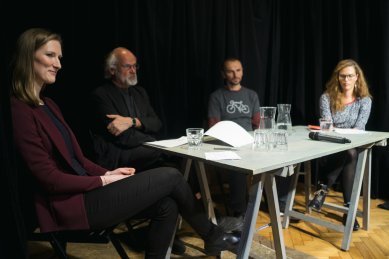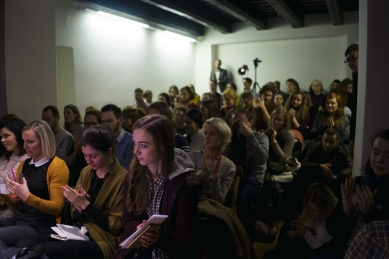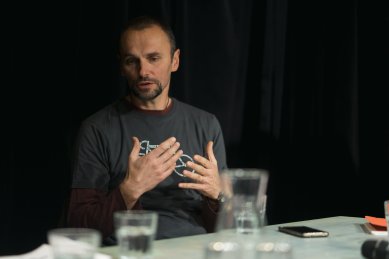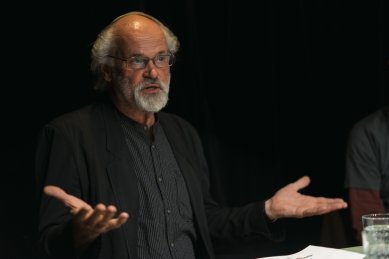
Boundary of Architecture - Notes from the First Discussion Evening
theme Homeless People and Public Space
Source
Ing. arch. Karolína Kripnerová, Architekti bez hranic, z.s.
Ing. arch. Karolína Kripnerová, Architekti bez hranic, z.s.
Publisher
Tisková zpráva
24.04.2018 22:05
Tisková zpráva
24.04.2018 22:05
Czech Republic
Prague
```html
Where does architecture begin and end? This question was posed by the organization Architects Without Borders. An organization that is interested in public space and interpersonal relationships. This led to the project of discussion evenings called The Borders of Architecture, which aims to bring architects and experts from other professions to the same table. The discussion evenings will provide a perspective on one topic from various angles, or conversely, a crystallization of a crossroads from different opinions. The discussion evenings of The Borders of Architecture are open to both professional and lay audiences. Audience involvement in the discussion, whether through questions or opinions, is welcomed.
The first discussion evening focused on the topic of Homeless People and Public Space. Do urban planners and social curators address common topics? How is the education of young urban planners conducted? Or how does society's attitude towards homeless people evolve? These were the questions raised during the discussion evening of The Borders of Architecture in January 2018. Architect and urban planner Jiří Klokočka and social curator Pavel Pěnkava accepted the invitation.
The Majority Society and Homeless People
The attitude of the majority society towards homeless people has evolved significantly since the nineties. The post-revolutionary tolerance combined with pity is gradually turning into indifference, which goes hand in hand with insufficient systemic solutions to this problem. Society is now starting to awaken and realizes that a relatively large group of homeless residents live among us, and this group is growing.
Current attitudes of the majority society towards homeless people can be observed, for example, in how impossible it is today to establish a new social service (a specific facility where support should be provided) in the capital city; no one wants it in their neighborhood. Yet, it is precisely the society's attitude towards its weaker members that reflects its maturity. The public accepts that resources must be spent to help homeless people, but the prevailing opinion is: Help them, but don't let it cost too much. The result is a strong emphasis on satisfying basic needs (food, sleep, and others) and support for them, but prevention is not nearly addressed. Meanwhile, preventive measures are the foundation of success.
Homelessness
Who is a homeless person? There are many definitions, but saying which one is correct is complicated. Social curator and head of the social prevention department in Prague 1, Pavel Pěnkava, believes that the problem of these people lies in their inability to live in relationships: to maintain them and, above all, to develop them. Relationships are the alpha and omega of a satisfied life.
A large part of the people living on the street has experience with institutional upbringing. This can involve growing up in a children's home or serving a prison sentence. Experts on homelessness, Ilja Hradecký and Libor Prudký, agree that up to two-thirds of the homeless have gone through a children's home. The connection between homelessness and the structure of the housing stock is also interesting. During the rapid privatization of the housing stock in the nineties, the number of homeless people sharply increased. These were people living in municipal apartments that were privatized during their incarceration.
Approach Abroad
Architect Jiří Klokočka, who spent most of his professional life in Belgium as the chief architect of the urban studio in the city of Kortrijk, shared his experiences from abroad in the discussion. One of the studio's activities was designing public space.
The housing market situation in Belgium is different. Since World War II, there has been a system of social housing, making it completely normal. In numerical terms, 6% of the housing stock consists of social housing, managed by so-called housing associations. Naturally, there is a high demand for this type of housing. The system establishes criteria for how the "queue for apartments" is formed: income ceiling, number of children, and disability. Priority is also given to seniors who sold a larger house or apartment, and individuals whose property has been expropriated in the public interest. The government's goal is to build fifty thousand more such apartments by 2025, bringing the share of social housing up to 9% of the housing market.
The state realizes how necessary it is to engage private developers in cooperation. It mandates that in new housing projects, a quarter of the apartments must be social. And if a developer intends to create purely luxury housing? Then they must invest elsewhere and build the required social apartments there. Belgian society recognizes the importance of public interest over private, which is reflected in the "STOP" principle applied in street design. Pedestrians take precedence over all, followed by cyclists, then public transport, and finally individual transport – cars.
Future Social Workers
A social worker is someone who helps others and addresses their urgent situations. The scope of their work is vast; they work with alcoholics, delinquents, homeless people, and other groups of residents. In their work, they distinguish the person they see in front of them and their behavior, so they do not personalize problems. What is the prestige of the social work profession? In our society, there is astonishment as to why people want to do this job. The profession has received a negative label without its own fault, which it struggles to deal with. Social workers find it hard to present themselves: "I am a social worker, and who is more?"
Surveys suggest that in multidisciplinary teams, social workers exhibit the lowest self-confidence. Yet they are precisely the ones who must act as coaches at the round table, leading the activities of involved professionals (such as psychologists, lawyers, or special educators) to a successful goal: solving the urgent situation of the person in need.
Social Topics in Urbanism Education
Educating a young urban planner is a complicated discipline. An urban planner must master a wide range of tools and understand the complexity of a city. Highlighting the issues of disadvantaged people, or directly homeless people, is still a marginal concern. Not all students perceive it or consider it central to their interest. Nonetheless, the teacher has some soft tools at their disposal, for example, explaining the benefits of spaces where society can meet, discuss, and smooth out the edges between individual differences. These might include community gardens, courtyard spaces, or green roofs on administrative buildings, where employees can spend their lunch breaks together.
And what can be said in conclusion?
We often have greater fear of the fear itself than the problem itself. This is also typical for society's attitude towards homelessness. The best prevention is to name and explain the problem; perhaps then we won't be afraid of something that is not really a risk at all.
Note: The above text is a shortened version of the minutes from the discussion evening The Borders of Architecture: Homeless People and Public Space, which took place on January 16, 2018, at the Czech Scout Institute in the Old Town Square. The event was organized by Architects Without Borders.
(Speakers Ing. arch. akad. arch. Jiří Klokočka and PhDr. Pavel Pěnkava)
Ing. arch. akad. arch. Jiří Klokočka studied architecture at the Czech Technical University in Prague and the Academy of Fine Arts. Since 1980, he has lived and worked in Belgium, where he served as the chief architect of the urban studio in the city of Kortrijk. He is currently a member of the urban planning commissions in several cities and municipalities in Belgium and collaborates externally with the Office of the Architect of the City of Brno. Ing. arch. akad. arch. Jiří Klokočka teaches at the Faculty of Architecture of the Technical University of Liberec and the Faculty of Architecture of the Czech Technical University in Prague, where he leads his own studio at the Institute of Urbanism.
PhDr. Pavel Pěnkava studied social pathology and prevention and subsequently social pedagogy at the University of Hradec Králové. He works as a social curator and head of the social prevention department of Prague 1. He worked at the counseling center for homeless individuals at the Prague Social Services Center. Since 2006, he has been the chairman of the social curators section at the Society of Social Workers of the Czech Republic. He collaborates with both Czech and international organizations that address the issue of homelessness. PhDr. Pavel Pěnkava teaches at the Department of Social Work at the Faculty of Arts of Charles University.
The author of the article Ing. arch. Karolína Kripnerová is an architect and co-founder of the organization Architects Without Borders. In her doctorate studies at the Faculty of Architecture of the Czech Technical University in Prague, she focuses on the topic of Social Sustainability from an architectural perspective.
Architects Without Borders is a non-profit organization that brings together architects and designers interested in public space. The organization's goal is to initiate and participate in projects for disadvantaged people, cultivate public space, and strengthen interpersonal relationships. Architects Without Borders is behind, among other things, the realization of the Orientation System in the underpasses under the Hlávka Bridge or the initiative of Public Wardrobes in Prague.
The series of public debates The Borders of Architecture was supported by a grant from the Czech Architecture Foundation.
More information > ```
The first discussion evening focused on the topic of Homeless People and Public Space. Do urban planners and social curators address common topics? How is the education of young urban planners conducted? Or how does society's attitude towards homeless people evolve? These were the questions raised during the discussion evening of The Borders of Architecture in January 2018. Architect and urban planner Jiří Klokočka and social curator Pavel Pěnkava accepted the invitation.
The Majority Society and Homeless People
The attitude of the majority society towards homeless people has evolved significantly since the nineties. The post-revolutionary tolerance combined with pity is gradually turning into indifference, which goes hand in hand with insufficient systemic solutions to this problem. Society is now starting to awaken and realizes that a relatively large group of homeless residents live among us, and this group is growing.
Current attitudes of the majority society towards homeless people can be observed, for example, in how impossible it is today to establish a new social service (a specific facility where support should be provided) in the capital city; no one wants it in their neighborhood. Yet, it is precisely the society's attitude towards its weaker members that reflects its maturity. The public accepts that resources must be spent to help homeless people, but the prevailing opinion is: Help them, but don't let it cost too much. The result is a strong emphasis on satisfying basic needs (food, sleep, and others) and support for them, but prevention is not nearly addressed. Meanwhile, preventive measures are the foundation of success.
Homelessness
Who is a homeless person? There are many definitions, but saying which one is correct is complicated. Social curator and head of the social prevention department in Prague 1, Pavel Pěnkava, believes that the problem of these people lies in their inability to live in relationships: to maintain them and, above all, to develop them. Relationships are the alpha and omega of a satisfied life.
A large part of the people living on the street has experience with institutional upbringing. This can involve growing up in a children's home or serving a prison sentence. Experts on homelessness, Ilja Hradecký and Libor Prudký, agree that up to two-thirds of the homeless have gone through a children's home. The connection between homelessness and the structure of the housing stock is also interesting. During the rapid privatization of the housing stock in the nineties, the number of homeless people sharply increased. These were people living in municipal apartments that were privatized during their incarceration.
Approach Abroad
Architect Jiří Klokočka, who spent most of his professional life in Belgium as the chief architect of the urban studio in the city of Kortrijk, shared his experiences from abroad in the discussion. One of the studio's activities was designing public space.
The housing market situation in Belgium is different. Since World War II, there has been a system of social housing, making it completely normal. In numerical terms, 6% of the housing stock consists of social housing, managed by so-called housing associations. Naturally, there is a high demand for this type of housing. The system establishes criteria for how the "queue for apartments" is formed: income ceiling, number of children, and disability. Priority is also given to seniors who sold a larger house or apartment, and individuals whose property has been expropriated in the public interest. The government's goal is to build fifty thousand more such apartments by 2025, bringing the share of social housing up to 9% of the housing market.
The state realizes how necessary it is to engage private developers in cooperation. It mandates that in new housing projects, a quarter of the apartments must be social. And if a developer intends to create purely luxury housing? Then they must invest elsewhere and build the required social apartments there. Belgian society recognizes the importance of public interest over private, which is reflected in the "STOP" principle applied in street design. Pedestrians take precedence over all, followed by cyclists, then public transport, and finally individual transport – cars.
Future Social Workers
A social worker is someone who helps others and addresses their urgent situations. The scope of their work is vast; they work with alcoholics, delinquents, homeless people, and other groups of residents. In their work, they distinguish the person they see in front of them and their behavior, so they do not personalize problems. What is the prestige of the social work profession? In our society, there is astonishment as to why people want to do this job. The profession has received a negative label without its own fault, which it struggles to deal with. Social workers find it hard to present themselves: "I am a social worker, and who is more?"
Surveys suggest that in multidisciplinary teams, social workers exhibit the lowest self-confidence. Yet they are precisely the ones who must act as coaches at the round table, leading the activities of involved professionals (such as psychologists, lawyers, or special educators) to a successful goal: solving the urgent situation of the person in need.
Social Topics in Urbanism Education
Educating a young urban planner is a complicated discipline. An urban planner must master a wide range of tools and understand the complexity of a city. Highlighting the issues of disadvantaged people, or directly homeless people, is still a marginal concern. Not all students perceive it or consider it central to their interest. Nonetheless, the teacher has some soft tools at their disposal, for example, explaining the benefits of spaces where society can meet, discuss, and smooth out the edges between individual differences. These might include community gardens, courtyard spaces, or green roofs on administrative buildings, where employees can spend their lunch breaks together.
And what can be said in conclusion?
We often have greater fear of the fear itself than the problem itself. This is also typical for society's attitude towards homelessness. The best prevention is to name and explain the problem; perhaps then we won't be afraid of something that is not really a risk at all.
Note: The above text is a shortened version of the minutes from the discussion evening The Borders of Architecture: Homeless People and Public Space, which took place on January 16, 2018, at the Czech Scout Institute in the Old Town Square. The event was organized by Architects Without Borders.
(Speakers Ing. arch. akad. arch. Jiří Klokočka and PhDr. Pavel Pěnkava)
Ing. arch. akad. arch. Jiří Klokočka studied architecture at the Czech Technical University in Prague and the Academy of Fine Arts. Since 1980, he has lived and worked in Belgium, where he served as the chief architect of the urban studio in the city of Kortrijk. He is currently a member of the urban planning commissions in several cities and municipalities in Belgium and collaborates externally with the Office of the Architect of the City of Brno. Ing. arch. akad. arch. Jiří Klokočka teaches at the Faculty of Architecture of the Technical University of Liberec and the Faculty of Architecture of the Czech Technical University in Prague, where he leads his own studio at the Institute of Urbanism.
PhDr. Pavel Pěnkava studied social pathology and prevention and subsequently social pedagogy at the University of Hradec Králové. He works as a social curator and head of the social prevention department of Prague 1. He worked at the counseling center for homeless individuals at the Prague Social Services Center. Since 2006, he has been the chairman of the social curators section at the Society of Social Workers of the Czech Republic. He collaborates with both Czech and international organizations that address the issue of homelessness. PhDr. Pavel Pěnkava teaches at the Department of Social Work at the Faculty of Arts of Charles University.
The author of the article Ing. arch. Karolína Kripnerová is an architect and co-founder of the organization Architects Without Borders. In her doctorate studies at the Faculty of Architecture of the Czech Technical University in Prague, she focuses on the topic of Social Sustainability from an architectural perspective.
Architects Without Borders is a non-profit organization that brings together architects and designers interested in public space. The organization's goal is to initiate and participate in projects for disadvantaged people, cultivate public space, and strengthen interpersonal relationships. Architects Without Borders is behind, among other things, the realization of the Orientation System in the underpasses under the Hlávka Bridge or the initiative of Public Wardrobes in Prague.
The series of public debates The Borders of Architecture was supported by a grant from the Czech Architecture Foundation.
More information > ```
The English translation is powered by AI tool. Switch to Czech to view the original text source.




0 comments
add comment
Related articles
0
14.09.2024 | International Meeting of Architects Without Borders
0
31.01.2019 | Limits of Architecture - Notes from the Fourth Discussion Evening
0
18.12.2018 | Limits of Architecture - Minutes from the Third Discussion Evening
0
19.11.2018 | Borders of Architecture: Functional Tourism
0
14.09.2018 | Boundary of Architecture - Minutes from the Second Discussion Evening
0
19.03.2018 | Boundaries of Architecture: Commercialization of Public Space
0
09.01.2018 | Boundaries of Architecture: Homeless People and Public Space











